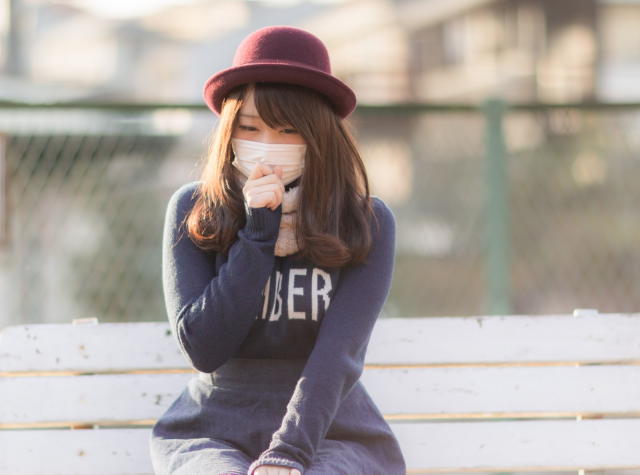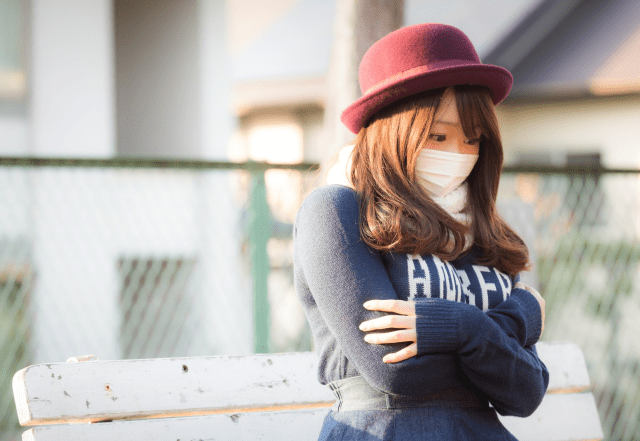
Dress code detail is a waste of time to even discuss, frustrated junior high teacher says.
It’s not uncommon to see people in Japan wearing surgical masks while they’re out and about. While some overseas visitors mistakenly think the practice has something to do with air pollution in Japan’s urban areas, that’s not the case. The primary reasons people in Japan wear masks are to avoid pollen during the country’s severe hay fever season in spring and to prevent catching colds from coworkers or classmates when spending extended periods inside enclosed spaces in the winter.
In a country where workers and students alike are constantly busy, no one wants to have to take a sick day, and so wearing a mask isn’t seen as a sign of hypochondria, but one of admirable dedication to your work or studies. However, Japanese schools, being Japanese schools, can’t help but want to regulate every possible aspect of their students’ conduct, which brings us to this tweet from Japanese middle school teacher @barbeejill3.
昼からの会議で「白以外のマスクの使用」について30分程時間を使った…
— 合法先生 (@barbeejill3) December 25, 2018
「真っ白でない薄い水色のものや、薄いピンクのものは華美かオシャレか?」
「黒のマスクは華美かオシャレか?」
【結論】
「中学生らしく白のみ使用可」
私は何色でもいい。
それよりこんな事に30分使う事をやめて欲しい…
“In our afternoon meeting today at work, we spent 30 minutes talking about whether or not students should be allowed to wear masks that are a color other than white…
‘Are light blue or light pink masks too showy and fashionable? Are black ones?’
In the end, the decision was ‘Only white masks will be allowed, because they’re middle school student-like.’
Personally, I don’t care what color mask the students wear, and I wish we’d stop wasting entire half-hours on stupid topics like this.”
This isn’t the first tale of a heavy-handed dress code at a Japanese school, as it comes after other educational institutions dictated the color of students’ underwear and banned “lust-inducing” ponytails. Still, the fact that wearing a mask is widely thought to have health benefits had many online commenters echoing @barbeejill3’s frustration:
“This is so dumb…What’s the baseline for determining if something is ‘middle school student-like?’”
“Isn’t this just a case of middle-aged school employees reacting negatively to colors they’re not used to?”
“Masks are masks.”
“You hear these government studies that say how busy teachers are…so why are they wasting energy checking and enforcing pointless things like this? Shouldn’t they have more faith in their students?”
Then there was the Twitter user who pointed out that even professional-spec masks used by medical professionals are sometimes a color other than white, and it’s not like such vivid hues are leading to improper patient care.
手術室など医療現場で使用されるサージカルマスクは多くのものに色のついたフィルターが入っています。
— MOTOA (@motoa_well_br) December 25, 2018
水色やピンクが華美かどうかという議論は不要だし無知過ぎます。
生徒をインフルエンザの危険から守るためにこの事実を早急に知らせるべきではないでしょうか? pic.twitter.com/oAvqUvkNBw
Still, it’s likely that in the school’s opinion, masks, by default, are white. That’s the color most prevalently stocked in stores and worn on the street, and there are indeed some people who choose other colors for aesthetic reasons (which may be why plain white masks were considered the least “attractive” in one survey). From that perspective, maybe it’s not so surprising that the school came to the conclusion “white mask=health equipment, colored mask=fashion accessory,” and since Japanese middle school students aren’t allowed to wear necklaces or earrings, the school wouldn’t want them to wear discretionarily fashionable masks either.
Of course, it’s also worth considering that because students are all facing the same way when seated for class, all they see if the back of their classmates’ heads, which should really limit how much of a distraction a non-white mask could potentially be, since the offending color would be almost entirely invisible during the teacher’s lecture. Unfortunately, the decision is out of @barbeejill3’s hands, but his incognito online griping about it is a reminder that when Japanese teachers enforce baffling regulations, it might not always be by choice.
Source: Twitter/@barbeejill3 via Jin
Top image: Pakutaso
Insert images: Pakutaso
Follow Casey on Twitter, where he’s already stockpiling masks for hay fever season.


 Domino’s Pizza Japan offers discount to customers in masks for limited time
Domino’s Pizza Japan offers discount to customers in masks for limited time Japanese middle school criticized for pulling out girls’ bra straps to check their color
Japanese middle school criticized for pulling out girls’ bra straps to check their color Wearing a white mask will make you less attractive, according to Japanese researchers’ experiment
Wearing a white mask will make you less attractive, according to Japanese researchers’ experiment Politician’s disgusting mask gaffe grosses out Japan【Video】
Politician’s disgusting mask gaffe grosses out Japan【Video】 Tokyo junior high school demands students wear white underwear as part of dress code
Tokyo junior high school demands students wear white underwear as part of dress code McDonald’s new Happy Meals offer up cute and practical Sanrio lifestyle goods
McDonald’s new Happy Meals offer up cute and practical Sanrio lifestyle goods All-you-can-drink Starbucks and amazing views part of Tokyo’s new 170 meter-high sky lounge
All-you-can-drink Starbucks and amazing views part of Tokyo’s new 170 meter-high sky lounge Studio Ghibli glasses cases let anime characters keep an eye on your spectacles
Studio Ghibli glasses cases let anime characters keep an eye on your spectacles Beautiful Sailor Moon manhole cover coasters being given out for free by Tokyo tourist center
Beautiful Sailor Moon manhole cover coasters being given out for free by Tokyo tourist center More foreign tourists than ever before in history visited Japan last month
More foreign tourists than ever before in history visited Japan last month Kyoto’s 100 Demons yokai monster parade returns!
Kyoto’s 100 Demons yokai monster parade returns! Super Nintendo World expansion gets delayed for several months at Universal Studios Japan
Super Nintendo World expansion gets delayed for several months at Universal Studios Japan Princesses, fruits, and blacksmiths: Study reveals the 30 most unusual family names in Japan
Princesses, fruits, and blacksmiths: Study reveals the 30 most unusual family names in Japan Starbucks reopens at Shibuya Scramble Crossing with new look and design concept
Starbucks reopens at Shibuya Scramble Crossing with new look and design concept Hamster abandoned at Tokyo ramen restaurant gets new home
Hamster abandoned at Tokyo ramen restaurant gets new home Disney princesses get official manga makeovers for Manga Princess Cafe opening in Tokyo
Disney princesses get official manga makeovers for Manga Princess Cafe opening in Tokyo Beautiful new Final Fantasy T-shirt collection on the way from Uniqlo【Photos】
Beautiful new Final Fantasy T-shirt collection on the way from Uniqlo【Photos】 Is the new Shinkansen Train Desk ticket worth it?
Is the new Shinkansen Train Desk ticket worth it? Foreign English teachers in Japan pick their favorite Japanese-language phrases【Survey】
Foreign English teachers in Japan pick their favorite Japanese-language phrases【Survey】 Japanese convenience store packs a whole bento into an onigiri rice ball
Japanese convenience store packs a whole bento into an onigiri rice ball We try out “Chan Ramen”, an underground type of ramen popular in the ramen community
We try out “Chan Ramen”, an underground type of ramen popular in the ramen community Studio Ghibli releases Kiki’s Delivery Service chocolate cake pouches in Japan
Studio Ghibli releases Kiki’s Delivery Service chocolate cake pouches in Japan Japan’s bone-breaking and record-breaking roller coaster is permanently shutting down
Japan’s bone-breaking and record-breaking roller coaster is permanently shutting down New definition of “Japanese whiskey” goes into effect to prevent fakes from fooling overseas buyers
New definition of “Japanese whiskey” goes into effect to prevent fakes from fooling overseas buyers Our Japanese reporter visits Costco in the U.S., finds super American and very Japanese things
Our Japanese reporter visits Costco in the U.S., finds super American and very Japanese things Studio Ghibli unveils Mother’s Day gift set that captures the love in My Neighbour Totoro
Studio Ghibli unveils Mother’s Day gift set that captures the love in My Neighbour Totoro Foreign passenger shoves conductor on one of the last full runs for Japan’s Thunderbird train
Foreign passenger shoves conductor on one of the last full runs for Japan’s Thunderbird train Domino’s Japan now sells…pizza ears?
Domino’s Japan now sells…pizza ears? New Japanese KitKat flavour stars Sanrio characters, including Hello Kitty
New Japanese KitKat flavour stars Sanrio characters, including Hello Kitty Kyoto creates new for-tourist buses to address overtourism with higher prices, faster rides
Kyoto creates new for-tourist buses to address overtourism with higher prices, faster rides Sales of Japan’s most convenient train ticket/shopping payment cards suspended indefinitely
Sales of Japan’s most convenient train ticket/shopping payment cards suspended indefinitely Sold-out Studio Ghibli desktop humidifiers are back so Totoro can help you through the dry season
Sold-out Studio Ghibli desktop humidifiers are back so Totoro can help you through the dry season Japanese government to make first change to romanization spelling rules since the 1950s
Japanese government to make first change to romanization spelling rules since the 1950s Ghibli founders Toshio Suzuki and Hayao Miyazaki contribute to Japanese whisky Totoro label design
Ghibli founders Toshio Suzuki and Hayao Miyazaki contribute to Japanese whisky Totoro label design Doraemon found buried at sea as scene from 1993 anime becomes real life【Photos】
Doraemon found buried at sea as scene from 1993 anime becomes real life【Photos】 Tokyo’s most famous Starbucks is closed
Tokyo’s most famous Starbucks is closed One Piece characters’ nationalities revealed, but fans have mixed opinions
One Piece characters’ nationalities revealed, but fans have mixed opinions We asked a Uniqlo employee what four things we should buy and their suggestions didn’t disappoint
We asked a Uniqlo employee what four things we should buy and their suggestions didn’t disappoint Mask rules in Japan have changed…so are people still wearing them?
Mask rules in Japan have changed…so are people still wearing them? Public schools in Japan’s Saga Prefecture will no longer regulate/check students’ underwear color
Public schools in Japan’s Saga Prefecture will no longer regulate/check students’ underwear color Majority of Nagasaki high schools and middle schools have white-underwear-only rules, study finds
Majority of Nagasaki high schools and middle schools have white-underwear-only rules, study finds Dumb Japanese school dress codes — Coronavirus winter edition
Dumb Japanese school dress codes — Coronavirus winter edition Special warm face masks for winter go on sale in Japan, and we test them out
Special warm face masks for winter go on sale in Japan, and we test them out Masks should still be worn indoors, majority of Japanese people in poll say
Masks should still be worn indoors, majority of Japanese people in poll say Line up in the hall, open your shirts, show your bras – Real instructions from one Japanese school
Line up in the hall, open your shirts, show your bras – Real instructions from one Japanese school Japanese McDonalds’ branch bans an entire middle school from entering the restaurant
Japanese McDonalds’ branch bans an entire middle school from entering the restaurant Japanese company creates “business card masks” that put your name and workplace on your face
Japanese company creates “business card masks” that put your name and workplace on your face Manga artist wants Japanese teachers to feel, for two seconds, how dumb their girls’ dress code is
Manga artist wants Japanese teachers to feel, for two seconds, how dumb their girls’ dress code is Kobe hospital robbed of 6,000 surgical masks
Kobe hospital robbed of 6,000 surgical masks “Students are only allowed three sneezes in class” Japanese people share their worst school rules
“Students are only allowed three sneezes in class” Japanese people share their worst school rules How tired of allergies are you? Thanko hopes enough to wear this giant USB-powered mask
How tired of allergies are you? Thanko hopes enough to wear this giant USB-powered mask Hilariously mundane cosplays from “Jimi Halloween” 2020 in Tokyo【Photos】
Hilariously mundane cosplays from “Jimi Halloween” 2020 in Tokyo【Photos】
Leave a Reply